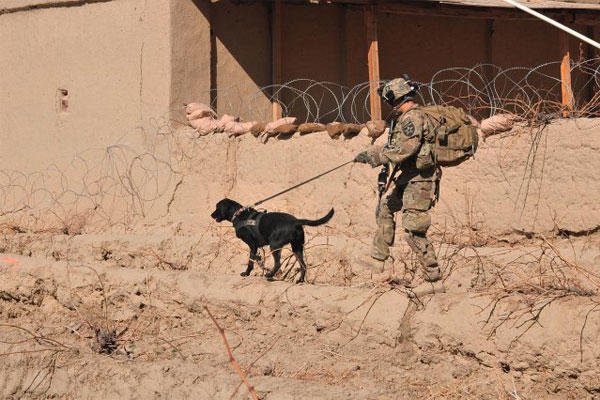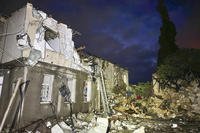FORWARD OPERATING BASE ZANGABAD, Afghanistan - After hours of climbing over the rugged grape rows of Afghanistan in search of a weapons cache, Pfc. Franklin Sena and his platoon heard the familiar sound of small-arms fire coming at them.
Since Sena could not positively identify the shooter to return fire, he got down and demanded his battle buddy lie low as well.
That is when Livee, his Tactical Explosives Detection Dog obediently listened and got down next to her handler.
Sena and Livee went on their first mission as a deployed team Feb. 7, in Shubazai, Afghanistan.
Soldiers in the TEDD program arrived almost two months after the brigade was already in country and had to stay on Kandahar Airfield to acclimate their dogs, said Sgt. 1st Class Adrian Copeland, a Provost Marshal Office noncommissioned officer and the TEDD program noncommissioned officer in charge for Combined Task Force 4-2 (4th Stryker Brigade Combat Team, 2nd Infantry Division).
"Because we came in a little late in the game...I believe maybe that the units are just trying to figure out how to work (the TEDD teams) in," he explained.
"I just hope they get the chance to go out and do something and maybe find an (improvised explosive device) or two," said Copeland. "I think that'll make their deployment."
During Sena's first deployment, his role is not only as an infantryman, but also a TEDD handler for his company, Company C, 4th Battalion, 9th Infantry Regiment.
Livee's job is to sniff out explosives and Sena is there to tell the rest of his company what she finds.
At the nine-week training he attended, he learned how to read things about Livee to include when she is tired, hot or has found something that could threaten the lives of the people around her, he said.
The training was not all fun and games for Sena.
There were a lot of challenges during the training because it is not like any other class like a Minehound or Handheld Interagency Identity Detection Equipment (HIIDE) or any other military class where it is a piece of machinery, Sena said.
"You can't push a button to turn it on and then it works," he said. "It takes a lot of time and practice and dedication to be able to work a dog, just because it has a mind of its own."
Some things that he did not see the purpose of during TEDD training began making sense on their first patrol.
"I wasn't expecting her to be able to walk along the narrow tops of the grape rows especially when the branches of the ... grape (vines) were in the way," Sena explained.
Livee pushed right through them, which Sena credits to training the two did before deployment.
During training, Sena would have Livee jump over the net at a tennis court to increase her jumping abilities, he said.
"She pretty much proved me wrong like all day," he said. "I was pretty impressed."
Though she handled the grape rows well, there was one thing Sena couldn't really control, he said.
When soldiers go on dismounted patrols, they clear a footpath with a Mine Hound, which detects the presence of IEDs buried underneath the ground.
Once the footpath is cleared, the left and right limits of the path are marked with spray paint. Soldiers call this the "Path of Life." No one is to step outside those lines for any reason.
However, sometimes Livee would momentarily step outside the lines, which didn't worry Sena too much, he said, because he knew that if there was something dangerous beneath the ground, Livee would have detected it.
Another aspect of training that Sena grew appreciation for during the first mission was when he and other TEDD handlers had to carry the dogs around and help them over walls and obstacles while still providing security for an element.
"Now that I'm out here and I see the terrain and what we had to go through today on my first mission, a lot of the training was really, really helpful," Sena said. "It was like one of those 'method to your madness' kind of things."
Sena said being a TEDD handler is like having a kid on the deployment, something Copeland said he agrees with.
"The closest thing to having a child is probably having a pet, like a dog," said Copeland.
It is a big responsibility and for some of the people, especially a lot of the soldiers that are in the TEDD program, because they are junior-enlisted Soldiers, he said.
"They're not used to having any kind of real responsibility because their only real responsibility in the Army up until now is taking care of themselves, but now they have the dog," he said.
Copeland said, to him, it's more of a benefit than an inconvenience for the soldiers because it gives them an opportunity to have some kind of responsibility early on in their careers.
Caring for Livee includes feeding and watering her, so Sena carries double the load when going out on mission because he has to be able to sustain himself and his TEDD.
The responsibility that comes with being a handler has positive outcomes, he said.
"I think it develops some pretty good leadership skills in a way," Sena explained.
"I'm just glad that I got picked for this because it's really a big part of my life," he said. "I don't know what I'm going to do when I have to give her back."





























